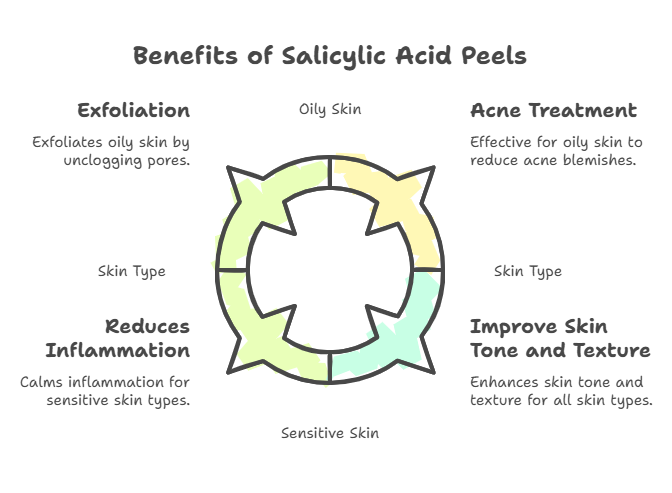Maybe you’ve noticed your skin isn’t as bright as it used to be. Or perhaps acne is more of a regular thing than a once-in-a-while issue. A salicylic acid peel might be the answer you’re looking for to bring out a smoother skin tone.
“Salicylic acid is one of the most effective ingredients for treating acne and exfoliating the skin because it can penetrate deep into the pores and clear out excess sebum and debris.”
Dr. Whitney Bowe
You are probably already doing your research on skin treatments. Here is more of what you need to know so that you can decide whether a salicylic acid peel is a good way to achieve a healthy skin glow.
What is a Salicylic Acid Peel?
A salicylic acid peel is a type of chemical peel used to exfoliate and rejuvenate the skin. This type of acid peel has been around for quite some time now. Some people have even turned to it for skin help for over 2,000 years.
Salicylic acid1 is a member of the beta hydroxy acid, or BHA, family. These peels come in varying strengths and are able to address a number of different skin problems.
So how do these peels help? Here’s what you should know.
How Does it Work?
Salicylic acid peels work by dissolving the bonds that hold dead skin cells together. This allows them to be shed more easily.
Because of its chemical makeup, salicylic acid is oil-soluble. That is what lets it penetrate pores to get rid of extra oil and debris.
People with acne or oily skin love this part because it helps with clearing up skin and avoiding future breakouts. This benefit is why salicylic acid peel is safe for all skin tones.
Concentrations and Strengths
You can typically find salicylic acid peels in concentrations from 10% to 30%. Lighter peels can often be bought and done at home. Stronger peels are best performed in a doctor’s office because they require a dermatologist to perform them.
For at-home peels, it is essential that you read all of the instructions for the salicylic peel. In that way, you are better equipped to protect your skin during the process.
Benefits of Salicylic Acid Peel
There are numerous reasons people use a salicylic peel to address and fix their problems. It might be exactly the thing to help improve the overall appearance and health of the skin.

Acne Treatment
A key reason that people get a salicylic acid peel is for helping with acne. Acne comes from skin cells that are dead or oils that are stuck within hair follicles. Regular use of salicylic acid peels can unclog pores2.
When pores are cleaned routinely, the amount of new acne blemishes are lowered.
Exfoliation
Salicylic acid peel has desmolytic properties. This is what lets it exfoliate your skin by disrupting the intercellular connections of the cells in your face.
If your skin seems rough, a peel might be a great way to achieve smooth, new skin. Regular chemical peels of this nature are proven to make your skin more attractive.
Reduces Inflammation
Acne is known for often creating red and sore skin inflammation around the affected location. You’ll want a method that helps clear your acne blemishes and calms the inflammation and the redness it can cause3.
At low amounts, it can provide the skin an anti-inflammatory outcome.
Improve Skin Tone and Texture
Do you notice a general dullness to your skin? Salicylic acid peel encourages the production of collagen and elastin. These will reduce scars.
Getting this procedure done regularly reduces fine lines. It also evens out skin tone after it has been scarred by acne.
Suitable for Various Skin Types
Salicylic acid peel is mostly safe for all skin tones. People who have skin that is oily or is a combination seem to benefit most. For skin that is extra sensitive or dry, proceed with extra care since peels have the possibility of increased irritation or dryness4.
It’s usually best to test out the acid on just a small location before you attempt the chemical peel.
What to Expect During and After a Salicylic Peel
So now you understand that there is plenty that a peel can do to bring healthy vibrance and glow to the surface of your face. But what will the actual session involve and what actions should you expect to be performing over the following weeks to keep your skin in good shape? Let’s discuss.
Before the Peel
Before your appointment, talk with your doctor on which procedure is best for your specific skin. You should also talk with them if you have ever had any reactions to peels previously, or allergic to some other treatments, particularly to aspirins.
Stop using any exfoliating products that might cause irritation for around a week ahead of getting the procedure. A little prep work is a worthy trade for long-term healthy skin benefits.
During the Peel
First, your face is cleaned to get any debris or surface oils out of the way. Next, a salicylic acid peel solution is brushed carefully all over the area, bypassing sensitive areas around the eyes and mucus membranes.
You might feel some mild tingling when the acid goes on your skin. But the provider will carefully watch for extra discomfort, and the peel can then be promptly taken away by use of a neutralizing solution5.
After the Peel
Skin could be a bit red or tight just after a salicylic peel. The intensity of the effects depends on the strength of the peel you used. Redness usually goes down within several hours.
For several days following, it’s very typical for skin to start peeling. It’s important that you allow this shedding to happen on its own. This action exposes and creates way for smoother skin to form.
In the days after a chemical peel you can aid in recovery by carefully moisturizing the skin regularly. Furthermore, religiously using sunblock is paramount as fresh new skin will be very sensitive.
Downtime and Recovery
With light salicylic peels, there tends not to be considerable downtime. You may very well return to the greater number of your usual activities straight away, while observing particular skin aftercare instructions, like hydrating.
Deeper-strength peels may require several days of visible recovery. It’s important to discuss your lifestyle expectations with a dermatologist so you’re fully prepared to make temporary adjustments that support proper healing and long-term maintenance of your refreshed skin. To learn how to align treatments with your daily habits and skin type, explore our guide on personalized skin care.
Choosing the Right Salicylic Acid Peel For Your Skin Type
As we talked about a bit previously, people’s faces all operate a little differently. Here is some further advice on what outcomes to expect with different strength acid strengths, especially according to various Fitzpatricks, oily or dry. This will enable you to come away with your face the best you can achieve.
For Oily and Acne-Prone Skin
Salicylic acid peels work effectively for people who deal with oily skin or skin that has more frequent breakouts. A higher strength formulation assists in regulating manufacturing of the oil and deeply clears up clogged skin that are already oil laden.
People who continually are looking for blackhead reduction tend to see good success on top of other good effects of minimizing the blackheads along the folds and features of the face.
For Dry and Sensitive Skin
Care is suggested for people who recognize with already touchy and dryer face cells. A peel strength, even although gentler in method, has nonetheless the potential to irritate if cells react badly.
It’s quality to go with decreased concentrations for an effective acid. Moreover, intensely hydrate both before and after, that manner dryness will not become an unnecessarily large problem.
Considering the Fitzpatrick Scale
The Fitzpatrick scale is the method dermatologists can apply in calculating distinct skin styles or hues, as additionally seeing how those could react, or face up to the harshness, of unique facials and acid concentrations.
Always make sure that experts know this kind of records earlier so that the whole thing from downtime to recovery is understood among doctor and client.
With light skin that doesn’t tan ever there may be little or no trouble getting most chemical face peels completed, including ones in this acid form.
Darker shades are generally the identical even though those may additionally have sensitivities based on any of numerous motives, along with already terrible treatment or some prior circumstance that created scar tissues or maybe moles that require attention, too.
Potential Side Effects and Risks of Chemical Peels
While this type of process is usually taken into consideration low chance, its essential for folks that plan on doing it recognize all that they’re putting themselves in for. Those may mean understanding each of the after results that may occur from proper methods, in addition to much rarer occurrences.
Common Side Effects
Common acid outcomes consist of the opportunity of the aforementioned redness that typically comes quickly at the onset after any method.
Also the probability of light but choppy peel can take area alongside your facial strains and folds, although those are welcomed due to the fact you know these are the former surface of your facial area being removed as new face develops. You will likely have higher sunlight sensitivities given your outer defense has briefly come off.
A smaller, rarer outcome is temporary inflammation that is effortlessly managed through topically making use of hydrocortisone-based cream for a restricted period of time as consulted and counseled with an expert doctor in similar region and space.
Rare but Serious Risks
Though unusual, more critical acid threats are nonetheless to remember for the reason of fully prepared measures: An instance could be long-lasting adjustments which might encompass some scarring because even normal face tissue comes off together with the purpose surface that you may also be seeking to get fixed and restored.
Infections and allergies also can affect you which requires that the doctor in fee could make instant assessments alongside a certified plan that you are to then additionally perform going forward for appropriate fitness protection of yourself.
Speak to the relied on aesthetician inside proximity that could give you secure, proper care should those kinds of extraordinary instances ever unexpectedly gift themselves because your health and proper, safe procedure comes first at all times.
Home vs. Professional Salicylic Acid Peels
There may be huge debate in beauty circles concerning regardless of whether at domestic carried out, off the shelf treatments of this sort are alright to utilize as properly, versus the ones found at local clinical or dermatologist offices only.
While protection, approach, product selection, and the understanding in understanding face kinds, could be factors the real solution comes down to. A study and dialogue with experts from either region needs to show how fine you approach what faces and results you desire for yourself with right salicylic practices.
Accessibility and Cost
Do-it-yourself chemical washes provide a larger quantity for purchase through numerous beauty companies, permitting many individuals accessibility no matter their personal situations, while remedies or other strategies that involve doctors cost much greater at a single case but are probably better done if issues are high danger, high ache, or are simply far too extreme that do-it-yourself face is a good decision.
This balance helps dictate which methods are pleasant among your finances to maintain that healthy searching after the entirety from pores cleared on upward.
Strength and Control
Ultimately professionals from a clinic offer you higher strengths in each product form AND manage as an outcome.
A professional in control, whether they’re inside their professional medical area setting alongside their understanding from understanding comparable issues daily, let them address, provide recommendation, AND display a high degree of outcomes that an at-home solution is just simply not able to deliver based off ability or potential that can also simply be outside skill to start in.
So a balance must constantly be on both elements when going forward.
Integrating Salicylic Acid Peels into Your Skincare Routine
Everyone’s skin agenda requires custom solutions for the long-term. Salicylic acid peel has multiple techniques used and strategies so to implement as an amazing and amazing method in continuing your goals.
Frequency of Use
Light strengths can safely make use of an extra common routine: every 2 weeks in case your frame helps with them so you need to consult with experts as continually given their expertise– if a expert approach, it’s better left to two to three months earlier than it gets constant.
Otherwise some skin might face over drying problems, irritation and others with comparable harsh reactions because from doing face approaches the ones methods are now intended.
This needs an expertise for sure, whether someone is dealing with normal or high concentration processes to have them succeed completely and correctly over years, but additionally lengthy standing facial health that needs equal care in keeping healthy, searching smooth at best ability forever.
Combining with Other Skincare Products
It will depend on how well products are used. Some people blend them effectively, while others do not. For example, certain moisturizers work great with restoration products. However, mixing too many chemicals can lead to bad results. This is especially true for new users who are just starting their journey to repair their skin.
Get professional advice sooner than usual. This is important, no matter your comfort with safety and quality. Those stay the most important long-term for positive..
Frequently Asked Questions
What does salicylic acid peel do for skin?
Salicylic acid peels exfoliate and unclog pores. They also reduce inflammation. This helps improve skin texture and treat acne. The acids loosen the connections among face cells. This helps the top layers of tissue to shed more easily. As a result, it reduces blocked pores and acne, making skin look better.
How long does it take for a salicylic acid peel to heal?
Recovery can take a few hours for lighter types. Most face styles return to normal within that time. Strong chemical peels may take about 7 to 14 sessions for noticeable results. This is because exposure to sunlight or certain products can harm the new skin. This does takes research.
What is the downtime for a salicylic acid peel?
Downtimes vary based on concentration. Typically, lighter concentrations last up to 24 hours until symptoms fade. However, harsher strengths can take a week or more for visible signs to improve. This also increases the risk of potential outcomes.
How often should I salicylic acid peel?
You can use acids every – 3 weeks together along with your skin specialist. Consider your skin type and tolerance before using acids this often for the best results. Always talk to skin consultants about this. Pores and chemicals can change over time. They are affected by many factors, like new chemicals or UV exposure. Both situations matter. Talk is excellent.
Conclusion
Adding a salicylic acid peel can provide significant advantages. If you’re dealing with bad pimples or odd skin textures, try using acids and treatments. They might be the solution you need.
Talk to experts about the best options for protection. They can help you find great alternatives to achieve the look you want, no matter the time.
Small Step, Big Impact
To ensure safe and effective results, always conduct a patch test before applying a salicylic acid peel, and consult with a dermatologist to determine the appropriate concentration and frequency for your skin type.
Listen to this article
This is an AI generated Podcast version of the article.
- https://www.webmd.com/drugs/2/drug-18-866/salicylic-acid-topical/salicylic-acid-keratolytic-topical/details[↩]
- https://pmc.ncbi.nlm.nih.gov/articles/PMC4554394/[↩]
- https://my.clevelandclinic.org/health/diseases/22765-inflammatory-acne[↩]
- https://www.dermapure.com/en/3-dos-and-donts-for-chemical-peel-aftercare/[↩]
- https://blog.reneerouleau.com/skincare-products-sting/[↩]



